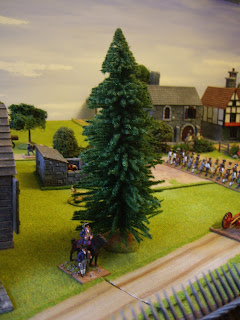Just a quick follow-on to the recent upload on my system for creating roads. Have now used the moleskin to provide several ploughed fields and, again, the material really does sit well on the static grass tabletop. Also included in the photos below, a miniature Christmas tree picked up in a charity shop yesterday for £1. It came with some rather nice scaled-down decorations, and only required a quick paint job to its original white plastic base.
MGB
Wargame Rules, Ratios, etc
RAISING MINIATURE ARMIES FOR THE LATE 18TH CENTURY
I am very keen to keep my wargame rules as simple as possible, yet capture the character of the 1790s. Morale dominates the games as the opposing sides are very different. Most of the French troops are 'levee' battalions, which I have chosen to base in column as their ability to change formation on a battlefield must have been limited, nor do I believe their volley fire had any great value. Of better quality, able to change formation, will be white-coated regular and blue-coated volunteer battalions, aided by a fair number of skirmishers. The British, Austrian, Dutch and German armies are often outnumbered, but they maintain the discipline and order of typical 18th century armed forces. Interestingly, French revolutionary cavalry have little in common with their later Napoleonic counterparts, the former are few in number, often poorly mounted, and no match for those in the service of the Allies. All figures are 28mm in scale, using a 1=25 ratio.
Followers
Subscribe to:
Post Comments (Atom)





Awesome table, love this atmospheric and superb terrain!
ReplyDeleteThank you Phil, the table really has come to life, and if you happen to place your palm anywhere on the table, its warm and pleasant to the touch.
DeleteMichael
Table looks great! I showed this post to my wife (a quilter who knows about fabric) and asked her about moleskin. Apparently no moles are involved! She wondered if you painted the rows and furrows, or if these were there already.
ReplyDeleteCheers,
Peter
Hi Peter, your good lady is correct, moleskin is a fabric which went under several regional names in England from the late 18th century, and is made of cotton. Now called moleskin, German post-war combat trousers were also described as such although theirs has a bit of a corduroy effect.. The stuff I have has no ridges in its weave and has been used for the fronts of traditional English bold-coloured waistcoats etc. Yes, I have painted all the effects, and it takes acrylic paint very well.
DeleteMichael
Fabulous looking table, wonderful!
ReplyDeleteThank you Chasseur for your kind comments, I was lucky to have this fabric in my store of cloth.
DeleteMichael
The table is really coming together in leaps and bounds. Looks absolutely tremendous.
ReplyDeleteCheers CB, clean and warm to the feel, and the figures can be moved with ease, its a working system.
DeleteMichael